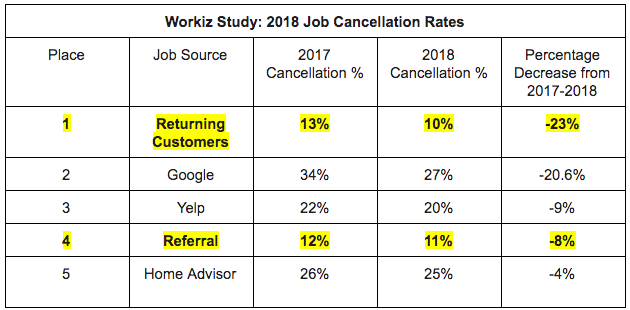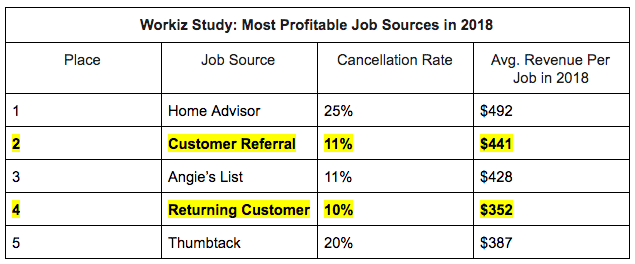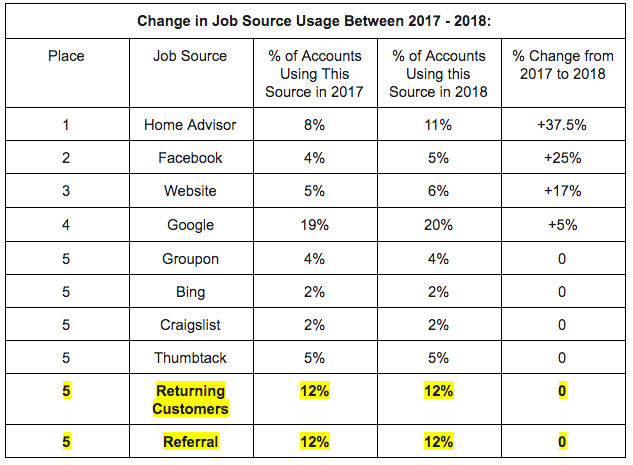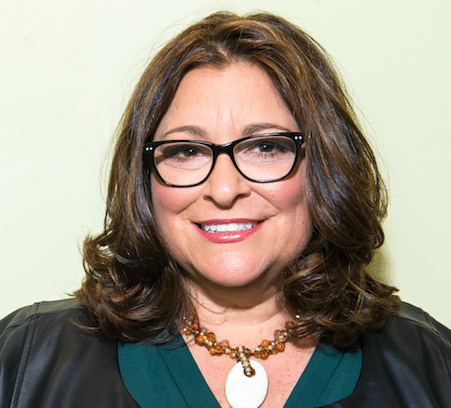This is one of the most important but constantly overlooked channels to grow your business and revenue and keep your best customers loyal, spending money and marketing on behalf of your business.
Repeat and referral business: Your money-making weapon
We recently surveyed almost 3,500 home service businesses to understand the best and worst advertising sources. The results caught us by surprise.
From our research we found that not only do repeat customers and customer referrals have some of the lowest cancellation rates of all existing lead sources, but are also one of the most profitable revenue channels for business owners- with some of the highest job prices (see tables below.)
Facts about your customers

Acquiring a new customer costs x5 as much as retaining an existing customer


You’re leaving money on the table
Here’s the really surprising part of the study, though – from 2017 to 2018, the number of home service businesses leveraging existing customers and customer referrals stayed exactly the same.
Meaning: Home service businesses aren’t getting better at / or just don’t know how to effectively leverage one of their most profitable revenue channels.

Wait, how much $$$ can you make?
If you weren’t already sold on the idea of remarketing to existing customers and leveraging customer referrals to grow your home service business – here are a few facts and figures which will definitely change your mind:
The stats are crazy:
- Acquiring a new customer can cost five times more than retaining an existing customer.
- The success rate of selling to a customer you already have is 60-70%, while the success rate of selling to a new customer is only 5-20%. Wow!
- Loyal customers are 5x as likely to repurchase, 5x as likely to forgive your business, 4x as likely to refer business, and 7x as likely to try a new offering than a new customer.
- U.S. companies lose $136.8 billion per year due to avoidable company switches.
- 33% of customers will consider switching companies after just one negative customer experience.
Facts about your customers

The success rate of selling to a customer is 60-70%, while the success rate of selling to a new customer is only 5-20%.
So, how can small businesses get more repeat business and customer referrals?
We decided to ask this question to 8 of the leading Small Business Experts and Influencers (seriously, these folks are some of the sharpest and know their stuff.) The question was simple: How can a small business get more repeat business and customer referrals?
Here’s what 8 of the leading Small Business Experts and Influencers advise.
[elementor-template id=”8572″]
Tip #1 – Carol Roth: Create a valuable incentive for customers to return

Offer additional products and services of interest, either at the point of sale (think McDonald’s “would you like fries with that”) or in between sales (such as web development firm offering website content and a link audit.)
According to Carol Roth, New York Times Bestselling author, former host of Microsoft’s Office Small Business Academy, and a Top 100 Small Business Influencer for five years running, there are two ways to earn repeat business from your existing customers.
“One is to get them to purchase more frequently, which means providing an outstanding product or service and creating valuable incentives for them to return. If you have a restaurant, you can send an offer for a free dessert.”
“Or sometimes, just ask. My cleaning personnel gets more business from me because they proactively schedule my next appointment instead of waiting for me to get around to doing it.”
“The second is to offer additional products and services of interest, either at the point of sale (think McDonald’s “would you like fries with that”) or in between sales (such as a web development firm offering website content and a link audit).”
Carol recommends trying to do both if possible “as it is more cost-effective to market to customers who already know, like and trust you than to find new customers.”
Facts About Your Customers

Loyal customers are 5x as likely to repurchase, 5x as likely to forgive your business, 4x as likely to refer business, and 7x as likely to try a new offering than a new customer.
Tip #2 – Gail Gardner: Show your customers that you really care

Multiple surveys have shown that buyers have no loyalty and change to a different seller because they don’t believe their existing source cares about their business. Small gestures can make a big difference.
Gail Gardner, Founder of the GrowMap and BizSugar Mastermind Community Manager, Staff Writer for Small Business Trends, and a Small Business Expert who has been published in Forbes, MSN Money, Yahoo Small Business, and more, says that showing appreciation for your customers is key.
“Multiple surveys have shown that buyers have no loyalty and change to a different seller because they don’t believe their existing source cares about their business. Small gestures can make a big difference.”
“For example, tucking a hand-signed note into a shipment thanking them for their order. Or even better, surprising buyers with a little gift you know they will like.”
Another way to show you care?
“Welcome feedback as a way to improve customer satisfaction. Making it easy to leave you anonymous feedback is a great way to head off bad reviews, too.”
“Businesses who avoid engaging with their customers have to continually pay for search traffic.”
“It is a lot more profitable to make sure your customers know how much you appreciate them, so they keep coming back and buying more!”
Tip #3 – Brian Moran: Thank customers for referring you business

If they (customers) were referred by someone, immediately reach out to the person or business making the referral and thank them.
According to Brian Moran, CEO and Founder of Small Business Edge, strategic advisor to business owners and entrepreneurs, and a former publisher of magazines and newspapers for small business owners, such as The Wall Street Journal, Inc. magazine and Entrepreneur magazine, the best way to get repeat business from your customers is by maintaining an open dialogue with customers.
“First, understand why they initially chose you over other companies. Was it convenient? Quality? Price? Customer service? Remember – customers will buy from you for different reasons.”
“So, if you send out the same marketing message (e.g., our service is the most convenient for customers), you may turn off customers who buy from you because of your customer service or quality of your product.”
And when it comes time to getting customer referrals, “make sure you find out how they heard about your company.”
“If they were referred by someone, immediately reach out to the person or business making the referral and thank them.”
“Then, treat your new customer as if they were your BEST customer…and the referrals will continue to knock on your door. Too many businesses forget to acknowledge and say thank you for referrals. Don’t make this mistake.”
Facts About Your Customers

U.S. companies lose $136.8 billion per year due to avoidable company switches.
[elementor-template id=”8572″]
Tip #4 – Steve Woodruff: Be specific when you ask for a customer referral

Ask for a very specific client referral (someone we know that they are connected to, say via LinkedIn or other industry contact); or, we can paint a verbal portrait of an ideal client (probably a lot like the existing customer) and ask if any of their industry contacts comes to mind.
Steve Woodruff, President of Clarity Fuel branding consultancy and author of the business book “Clarity Wins,” a how-to-guide for effectively creating clear messaging and generating referrals, shares that the best way to gain repeat business from existing customers is to keep selling to them.
“By that, I mean, keep reinforcing key messages about what you provide and how you differentiate.”
“Customers can become forgetful, and can develop a myopic view of their suppliers – we must never assume that even our customers truly know and remember what we do.”
Steve suggests an incremental approach.
“I suggest that a Small Business owner ask for a recommendation or testimonial for LinkedIn or a website – this indicates a willingness for the customer to speak well of the business provider.”
“Then, we can ask for a very specific client referral (someone we know that they are connected to, say via LinkedIn or other industry contacts); or, we can paint a verbal portrait of an ideal client (probably a lot like the existing customer) and ask if any of their industry contacts comes to mind.”
Tip #5 – Neelam Tewar: Deliver results before asking for a referral

Before asking, make sure you’ve delivered results and have a satisfied client; and ensure that the client you are asking a referral from is the type of client you want in future clients.
Neelam Tewar is global organic business growth and revenue strategist, two-time TEDx speaker, Youth Activator, and business coach to seven-figure business owners.
When it comes to getting repeat business from existing customers, Neelam’s advice is to “add value constantly without breaking your boundaries, i.e., ensure you get paid for your expertise and try to be respectful toward your own resources before you over-give.”
“This adds to the trust your existing customers’ place in you and allows them to see you as a partner who is by their side, understands their business, and thinks long term.”
And when it comes time to ask for a customer referral, Neelam advises doing so only after providing value first.
“Before asking, make sure you’ve delivered results and have a satisfied client; and ensure that the client you are asking a referral from is the type of client you want in future clients. If your existing client or their business doesn’t inspire you or help your business expand its expertise, then they are not an ideal client, and chances are their referrals are not going to be the right fit for your business growth.”
“It helps to be discerning when asking for referrals.”
Facts About Your Customers

33% of customers will consider switching companies after just one negative customer experience.
Tip #6 -Tanya Kraisingr: Ditch the hard sales and provide value

Make them (customers) feel like they’re the only one. Make it a point to remember something personal about them, their home, dogs name.
According to Tanya Kraisingr, Speaker and Business Strategy and Development consultant to fortune 500 companies, million dollar start-ups to grassroots and small business ventures, it’s about ditching the hard sales.
“They used your service, so they’re already sold. Let go of the hard sales and speak to them like someone that doesn’t need to be convinced. “
Instead of being in hard-sales mode, Tanya suggests “making them feel like they’re the only one,” which means “making it a point to remember something personal about them, their home, dogs name.
Being able to reference this information will make them feel special and recognized.
Remember, people won’t remember what you did, but they’ll remember how you made them feel.”
Her tips are practical, helpful, and highly actionable, like sending your customer reminders.
“If you have a service that is beneficial to have done regularly, send a reminder when they are due for the service again.”
She also advises sending your customers personalized offers. “ If they (your customers) used your service before, then you know something about their needs. Send offers that relate to their previous service or upsells that compliment work they’ve received from you.”
However, if you’re going to send an email or communicate with customers, her tip is to “make it authentic. If you only show up in their inbox when you want something, they’ll eventually become deaf to your message. Give Value. Give Value. Give Value. Then ask for the sale.”
Tip #7 – Donna Cravotta: Send a three-step email sequence after completing any project

Get the people on your list to accustomed to hearing from you on a regular basis, so you are not always asking them to buy something, so you can also roll in the ask for referrals.
For Donna Cravotta, Founder of CEO and Social Pivot PR, a firm committed to marketing with intention and building relationships for their small business clients, her top recommendation is to create a three-step email sequence that is sent out after the close of any project.
“Email 1-Thank the customer for their trust and invite them to become part of your Facebook group.”
“Email 2-Provide them with a useful email that doesn’t ask them to buy anything here is how you care for…or a seasonal idea.”
“Email 3-Ask them Are you happy with the work email, and link to your preferred review site.”
After this, Donna recommends sending out a monthly email with more than just a sales message.
“Let’s say you own a painting company, write an article on the benefits of a Spring check-up on the external paint of your home. What small items can be uncovered and repaired before they become bigger issues?”
“The goal is to get the people on your list to get “accustomed to hearing from you on a regular basis, so you are not always asking them to buy something, so you can also roll in the ask for referrals.”
Facts About Referred Customers

Referral Marketing generates 3-5x higher conversion rates than any other channel and brings you a 25% higher profit margin.
[elementor-template id=”8572″]
Tip #8 – Bill Cates: Ask for an introduction prior to a referral

Referrals are pretty much worthless unless you get connected (introduced) by your customer or advocate. When speaking with customers, prospects, and advocates – use the words Introduce and Introductions.
Internationally recognized client-acquisition expert, four-time best-selling author, and speaker, and Professional Speakers Hall of Fame Member, Bill Cates, suggests that you always get an introduction to your referral.
“Referrals are pretty much worthless unless you get connected (introduced) by your customer or advocate. When speaking with customers, prospects, and advocates – use the words Introduce and Introductions.”
According to Bill, “the bullseye in asking for introductions is to suggest specific people you know your customer knows.”
“The next most effective way is to suggest categories of people – to narrow their focus to picture real people in their mind’s eye. Don’t just say, “Who do you know who we can help?” That’s the least effective way and rarely produces good results.”
Another thing to remember when asking for intros and referrals? Focus on a specific niche or a target market (sometimes referred to as a vertical market).
“Businesses who focus on one of more niche markets get more unsolicited referrals and have more success when asking directly for referrals. When you focus on a niche or target market – you become more referable because you know their issues better and have developed solutions specific to their world.”
“They know people like themselves – they even have friendly relations with some of their competitors and share resources. It’s easier to create a reputation for yourself and your business in a target market.”









